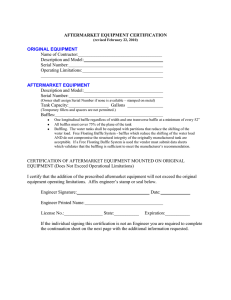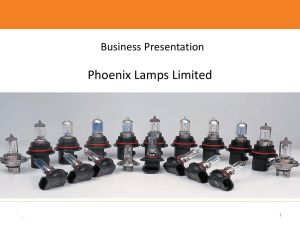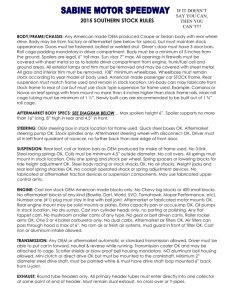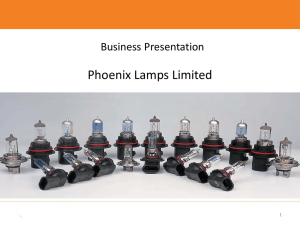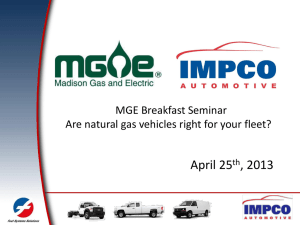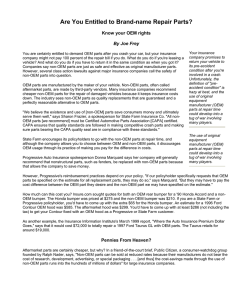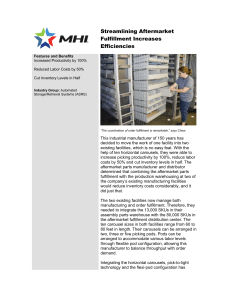Aftermarket Parts - Property Casualty Insurers Association of America
advertisement
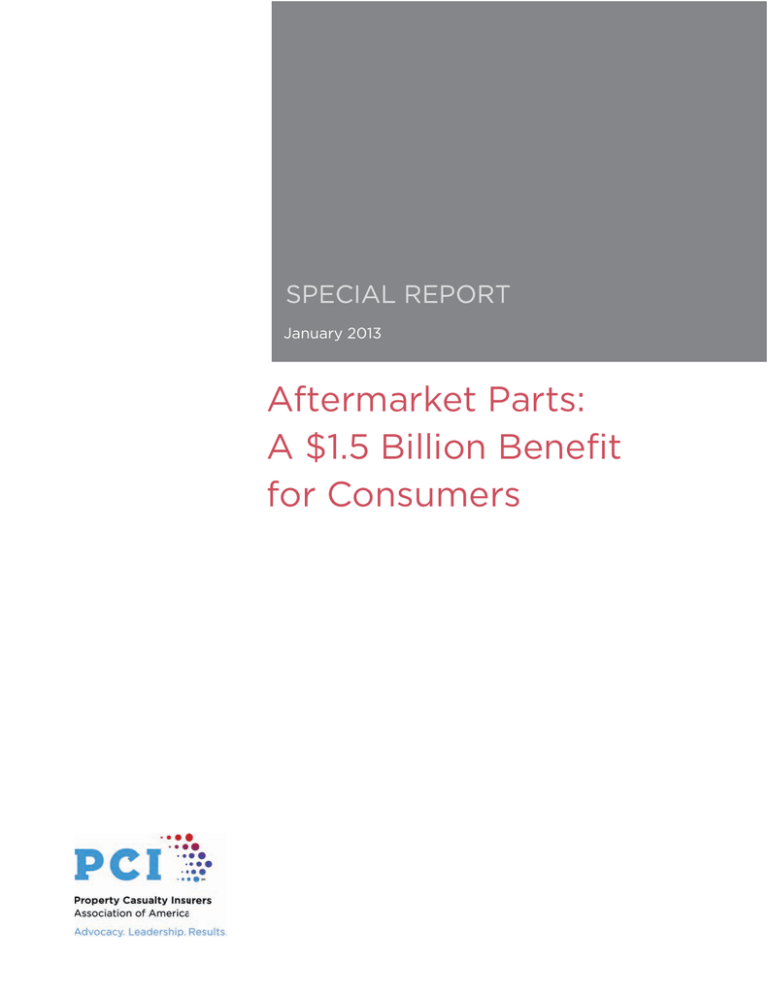
January 2013 Aftermarket Parts: A $1.5 Billion Benefit for Consumers Introduction For more than 25 years, aftermarket crash parts (also known as non-OEM parts or competitive replacement parts) have been used to repair damaged vehicles. These parts, which are not supplied by original equipment manufacturers (OEM), comprise the sheet metal or plastic components forming the vehicle’s exterior, such as hoods, door and bumper panels, fenders, side moldings, etc. Studies conclude that these exterior non-OEM aftermarket parts serve no safety function and do not compromise the safety of a vehicle.1 Because aftermarket parts are much less expensive than OEM parts, they are often used by body shops and insurance companies in an effort to reduce repair costs. In this way, consumers benefit by saving on out-of-pocket repair costs and through reduced automobile insurance premium growth due to lower claim costs. Aftermarket parts also allow more cars to be repaired and not totaled, benefiting consumers who do not have to replace (and finance) a new car and benefiting shops with repair jobs that they might not get otherwise. Furthermore, these alternative competitive replacement parts are readily available at more than 40,000 body shops nationwide. Quick access to these parts means fewer delays in repairs so personal and business vehicles can get back on the road promptly. This PCI Special Report provides an update of the estimated cost impact resulting from the banning of aftermarket parts. • If non-OEM competitive replacement parts are no longer used, this may result in an additional $1.5 billion in insurance costs per year that could be passed on to drivers in the form of higher premiums. • The average insurance premium reflecting vehicle damage coverages may increase by about 3.6 percent more per insured car. This translates into a 2.0 percent increase in the combined liability and physical damage premium per insured car if non-OEM parts could no longer be used. The Impact of Banning Non-OEM Parts Nationwide, there are about 23.8 million claims reflecting collision, property damage (PD) liability, comprehensive (excluding theft), and uninsured and underinsured motorist-property damage (UM/UIMPD) coverages in 2012.2 Roughly 3.3 million claims involve the use of non-OEM parts and 20.5 million claims involve the use of OEM parts. Total vehicle damage loss dollars are about $59.5 billion ($5.5 billion—non-OEM and $54.0 billion—OEM).3 In this analysis, the cost of labor and other items (i.e., towing and storage costs, sublet repair and other costs) is presumed to remain the same in terms of work related to OEM and non-OEM parts. Excluding labor and other items, total crash part costs are currently $26.8 billion ($2.5 billion—non-OEM and $24.3 billion—OEM). If the use of non-OEM components had already been banned, the cost for these aftermarket parts would have increased by about 60 percent (or an additional $1.5 billion). In other words, instead of $26.8 billion, the total cost of crash parts (now all OEM) would have been $28.3 billion (= $26.8 B + $1.5 B).4 1 GAO, “Motor Vehicle Safety: NHTSA’s Ability to Detect and Recall Defective Replacement Crash Parts is Limited” (1/01); and Insurance Institute of Highway Safety testimony before the National Conference of Insurance Legislators’ P/C Insurance Committee (7/07/05) 2 PCI, derived from an extrapolation using Fast Track Monitoring System (industry report) and National Association of Insurance Commissioners (NAIC) data [Minnesota was not included in the countrywide data since this state does not allow the use of aftermarket parts (source: PCI). The analysis also assumes that all companies pay for aftermarket parts.] The Fast Track Monitoring System is a publicly available report of automobile loss trends by coverage, prepared jointly by the Independent Statistical Service, Insurance Services Office, Inc. and National Independent Statistical Service. The NAIC data are obtained from its 2009/2010 Auto Insurance Database Report (2012 Edition). 3 PCI, derived from an extrapolation using Fast Track and NAIC data. 4 Ibid. Increase of $1.5 Billion in Insured Cost of Crash Parts Resulting From a Ban on Aftermarket Parts Nationwide An additional $1.5 billion in costs could have meant about a 3.6 percent increase in the total vehicle damage premium, or a 2.0 percent increase in the total liability and physical damage premium.5 Background Information The results in this report were derived using findings from various studies; they are as follows: • According to Mitchell, International, aftermarket parts represent 14 percent of the total cosmetic crash parts market. In contrast, OEM and other parts represent 86 percent of the total crash parts market.6 • The average price of an OEM part costs about 60 percent more than the average price of an aftermarket part.7 • The cost of parts is about 45 percent of the total auto body work.8 • Two other sources of data used in this analysis are the Fast Track Monitoring System9 and NAIC 2009/2010 Auto Insurance Database Report (2012 Edition). 5 The average premium reflects 2010 from the NAIC 2009/2010 Auto Insurance Database Report (2012 Edition). 6 Mitchell, International, “Industry Trends Report,” 1st Qtr. 2013 (p. 27) 7 Insurance Journal, “Alliance Hails DC Reg. Promoting Aftermarket Parts,” www.insurancejournal.com/news/east/2003/06/04/29512.htm 8 Mitchell, International, “Industry Trends Report,” 1st Qtr. 2012 (p. 21) 9 The Fast Track Monitoring System is a publicly available report of automobile loss trends by coverage, prepared jointly by the Independent Statistical Service, Insurance Services Office, Inc. and National Independent Statistical Service. PCI is comprised of more than 1,000 member companies, representing the broadest cross-section of insurers of any national trade association. PCI members write over $190 billion in annual premium and 40 percent of the nation’s property casualty insurance. Member companies write 46 percent of the U.S. automobile insurance market, 32 percent of the homeowners market, 38 percent of the commercial property and liability market, and 41 percent of the private workers compensation market. © 2013 Property Casualty Insurers Association of America 0113 | 2293 | 00
